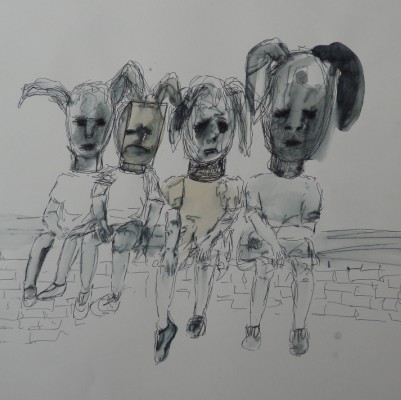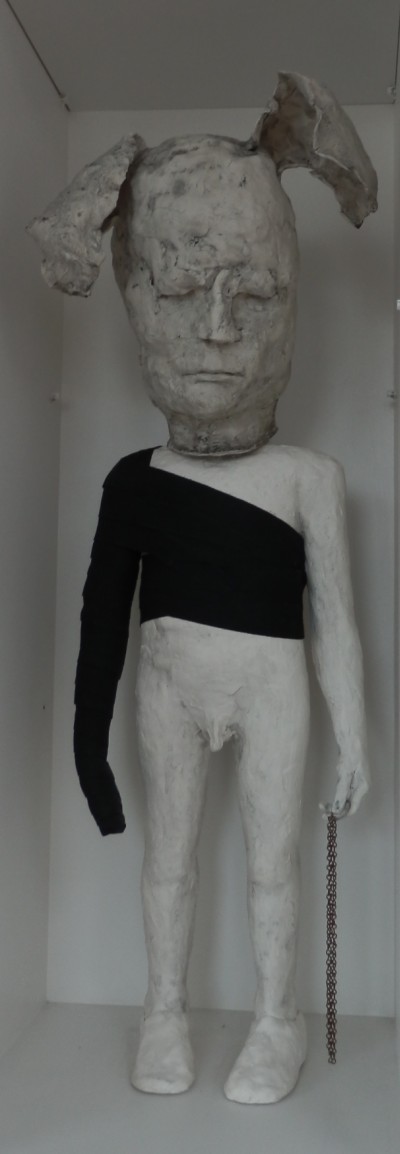Back in 2009, Pawn saw a piece of art which was particularly moving. Days later, he brought friend L back to see it, and she, too, found it moving. Finally, on the last day of the visit, he met up with new friend A, and she convinced him to buy it. Shortly before leaving for the airport, Pawn returned one last time to the Crypt of Saint Pancras Church, and uttered the fateful sentence, “If you can figure out how to ship it to me for a reasonable price, I’ll take it.â€
It took several weeks, but the intrepid Claire Palfreyman, maker of said artwork, found a shipper worthy of the task, and Short Stories, Volume 1, was on its way across the Atlantic, safely ensconced in a custom made crate, protected from buffeting. Shortly thereafter it was installed in Pawn’s state-side offices, and he has shared an office with it ever since. Pawn LOVES this piece of art, and is proud to have it in his collection.
Also on that last day in London, May of 2009, was fortunate enough to meet Claire, creator of Short Stories and to have a brief chat with her. Upon returning this year, I reached out to see if she would be up for a visit, so that I could see her other work, and chat about art. Yes, and yes, and today that happened.
I hopped the train, first the tube to Paddington and then the Heathrow Connect to Hanwell, where Claire and Charlie, her Parson’s Jack Russell, met me and led me to her home. We chatted over tea in her lovely kitchen while she told me of her current craft projects, built around her We Make Here classes, “Workshops where you meet, eat and create†as her website touts. We discussed her ceramics work, of which Short Stories is but one component, and about how art moves life just as life moves art.
In her studio, Claire shared sketches of work both realised and not, as well as stories of the late, missing partner to Short Stories, and a photo of this poor, ceramic soul. I admired the maquettes of work planned but not (yet) made, and, back in the house, some beautifully realised works.
Some more chat, and a lovely stroll, with Charlie along, back to the station to wait for the train back to London. I treasure making friends abroad. Claire was an artist whose work I bought, but after an afternoon of chat and shared appreciation of the role art can play in our lives, I’d like to think she’s a friend, too.
Friendship, and thing which move us, is also at the heart of tonight’s entertainment, Port Authority, at the Southwark Playhouse Vault. If there is a theme to our shows, last night and tonight, is of hidden vaults, dank and beautiful in their decay. Last night it was Old Vic Tunnels, under Waterloo Station. Tonight it was the vaults under London Bridge Approach. Southwark Playhouse has been using this space for some time, so it is not as “fresh†as OVT, but OMG what an atmosphere!

Port Authority - Southwark Playhouse
The play, by Irish playwright Conor McPherson, is entirely constructed of long soliloquy, a McPherson trademark. It wasn’t that long ago that both X and I saw The Good Thief, presented by Theatre Gigante, with Malcolm Tulip in the sole role, making a 60 minute address to the audience seated around him in the pub, as though he were merely talking to friends and acquaintances. Tonight we watched as Dermot (Ardal O’Hanlon), Joe (John Rogan) and Kevin (Andrew Nolan) each, separately, and with no regard or even awareness for each other, told us of those with whom they were close, loved, idolized or ignored.
Kevin is a young man, telling us of his first attempt to fly the coop, and of the woman he loved, and the woman he shagged, and of the difficulty of maintaining that distinction, all whilst following his mate’s bands and drinking to blinding excess.
Joe is an old man, living in care, who has a secret, well almost a secret, with which he has lived for over 40 years. He knows he is near the end of his allotment, and he knows his God will judge him (He knows), but he has a totem now, a keepsake, which speaks to him of a road not taken.
Dermot is a likeable buffoon, a poor, pitiable man whose life takes an unexpected turn, and then doubles back to leave him just where he was. His life has been full of these types of turns, but he hasn’t even realised it until he finds his head falling, falling into…
Well then, that would be giving it all away, wouldn’t it? No, the text is too good, the acting too real, the space too perfect and the production too effing well done. Go see it yourself!


























